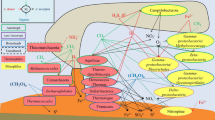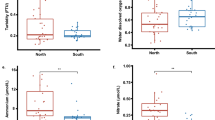Abstract
Observations were made on the distribution, morphology, and chemoautotrophic potential of microbial mats found in submarine caves of dolomitized limestone which contain hydrothermal sulphidic springs at Cape Palinuro, Italy. The distribution of microbial mats is closely associated with the flow of hydrothermal fluid from springs whose activity is intermittent and initiated during low tide. Fluid emitted from active springs in the Grotta Azzurra has a maximum temperature of 24.6°C and is enriched in dissolved sulfur species (H2S, S2O3 2−) and dissolved gases (CH4, CO2). However, it is depleted in NaCl and dissolved O2, in comparison with ambient seawater. This fluid is less dense and rises above the ambient seawater to form a visible thermocline and chemocline separating both layers in the submarine caves. Microbial mats were attached to rock surfaces immersed in fluid above the chemocline and were differentiated into brown and white forms. Brown mats were composed of trichomes (4.2 ± 0.1 μm and 20.3 ± 0.7 μm in diameter) resembling the calcareous rock-boring cyanobacterium Schizothrix and clusters (6 μm in diameter) of sarcina-like cells morphologically resembling methanogenic bacteria. White mats were composed of attached filaments resembling Beggiatoa (19.3 ± 0.5 μm, 39.0 ± 1.7 μm, and 66.9 ± 3.3 μm in diameter) and Thiothrix (4.2 ± 0.2 μm in diameter). Flexibacteria (<1 μm in diameter) were common to both mats. Beggiatoa-like filaments were morphologically similar to those attached to rocks and the byssal threads of mussels from Lucky Strike vent field on the Mid-Atlantic Ridge. Morphological comparisons were also made with typical gliding Beggiatoa from shallow seeps in Eckernförder Bucht, Baltic Sea. White mats displayed chemoautotrophic fixation of CO2 under relatively well-oxygenated laboratory conditions (maximum rate 50.2 nmol CO2/mg dry wt/h) using internal S0 or possibly S2O3 2− as electron donor. Photosynthesis may be limited in the Grotta Azzurra by insufficient illumination (6.3 × 10−7μ einsteins/cm2/s), with the possibility of Schizothrix living (at least in part) as a chemoheterotroph on white mats.
Chemoautotrophic fixation of CO2 by white mats is proposed as a significant source of nutrition for benthic fauna in these caves, and has been estimated as contributing 50–70 μmol CO2/m2 of mat/min, as measured under laboratory conditions.
Similar content being viewed by others
Author information
Authors and Affiliations
Additional information
Received: 18 June 1996; Accepted: 20 November 1996
Rights and permissions
About this article
Cite this article
Mattison, R., Abbiati, M., Dando, P. et al. Chemoautotrophic Microbial Mats in Submarine Caves with Hydrothermal Sulphidic Springs at Cape Palinuro, Italy. Microb Ecol 35, 58–71 (1998). https://doi.org/10.1007/s002489900060
Issue Date:
DOI: https://doi.org/10.1007/s002489900060




